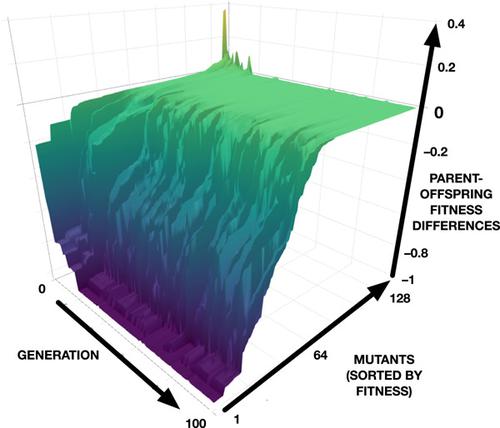当前位置:
X-MOL 学术
›
Evol. Dev.
›
论文详情
Our official English website, www.x-mol.net, welcomes your
feedback! (Note: you will need to create a separate account there.)
Developmental structuring of phenotypic variation: A case study with a cellular automata model of ontogeny.
Evolution and Development ( IF 2.6 ) Pub Date : 2019-09-11 , DOI: 10.1111/ede.12315 Wim Hordijk 1 , Lee Altenberg 2
Evolution and Development ( IF 2.6 ) Pub Date : 2019-09-11 , DOI: 10.1111/ede.12315 Wim Hordijk 1 , Lee Altenberg 2
Affiliation

|
Developmental mechanisms not only produce an organismal phenotype, but they also structure the way genetic variation maps to phenotypic variation. Here, we revisit a computational model for the evolution of ontogeny based on cellular automata, in which evolution regularly discovered two alternative mechanisms for achieving a selected phenotype, one showing high modularity, the other showing morphological integration. We measure a primary variational property of the systems, their distribution of fitness effects of mutation. We find that the modular ontogeny shows the evolution of mutational robustness and ontogenic simplification, while the integrated ontogeny does not. We discuss the wider use of this methodology on other computational models of development as well as real organisms.
中文翻译:

表型变异的发育结构:以个体发育的细胞自动机模型为例。
发育机制不仅产生生物表型,而且还构建了遗传变异映射到表型变异的方式。在这里,我们重新审视基于细胞自动机的个体发育进化的计算模型,其中进化规律地发现了两种实现选定表型的替代机制,一种表现出高度的模块化,另一种表现出形态整合。我们测量系统的主要变异特性,其适应性突变的分布。我们发现模块化本体论显示了突变鲁棒性和本体论简化的演变,而集成本体论则没有。我们讨论了这种方法在发展的其他计算模型以及真实生物上的更广泛使用。
更新日期:2019-09-11
中文翻译:

表型变异的发育结构:以个体发育的细胞自动机模型为例。
发育机制不仅产生生物表型,而且还构建了遗传变异映射到表型变异的方式。在这里,我们重新审视基于细胞自动机的个体发育进化的计算模型,其中进化规律地发现了两种实现选定表型的替代机制,一种表现出高度的模块化,另一种表现出形态整合。我们测量系统的主要变异特性,其适应性突变的分布。我们发现模块化本体论显示了突变鲁棒性和本体论简化的演变,而集成本体论则没有。我们讨论了这种方法在发展的其他计算模型以及真实生物上的更广泛使用。











































 京公网安备 11010802027423号
京公网安备 11010802027423号